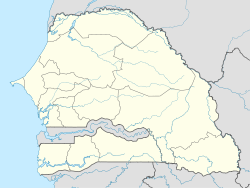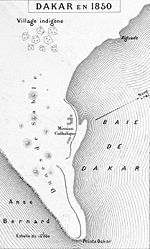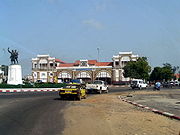
Dakar
About this schools Wikipedia selection
SOS Children made this Wikipedia selection alongside other schools resources. Click here for more information on SOS Children.
| Dakar Ville de Dakar |
|||
|---|---|---|---|
| Skyline of Central Dakar | |||
|
|||
| City of Dakar, divided into 19 communes d'arrondissement | |||
|
|
|||
| Coordinates: 14°41′34″N 17°26′48″W Coordinates: 14°41′34″N 17°26′48″W | |||
| Country | |||
| Région | Dakar | ||
| Département | Dakar | ||
| Settled | 15th century | ||
| Communes d'arrondissement |
19
|
||
| Government | |||
| • Mayor | Khalifa Sall (2009) ( BSS/PS) | ||
| • Regional president | Abdoulaye Wade (since 2002) | ||
| Area | |||
| • City | 82.38 km2 (31.81 sq mi) | ||
| • Metro | 547 km2 (211 sq mi) | ||
| Population (December 31, 2005 estimate) | |||
| • City | 1,030,594 | ||
| • Density | 12,510/km2 (32,400/sq mi) | ||
| • Metro | 2,452,656 | ||
| • Metro density | 4,484/km2 (11,610/sq mi) | ||
| Data here are for the administrative Dakar région, which matches almost exactly the limits of the metropolitan area | |||
| Time zone | GMT ( UTC+0) | ||
| Website | http://www.dakarville.sn | ||
Dakar is the capital city of Senegal, located on the Cap-Vert Peninsula, on the country's Atlantic coast. It is Senegal's largest city. Its position, on the western edge of Africa (it is the westernmost city on the African mainland), is an advantageous departure point for trans-Atlantic and European trade; this fact aided its growth into a major regional port.
According to December 31, 2005 official estimates, the city of Dakar proper has a population of 1,030,594, whereas the population of the Dakar metropolitan area is estimated at 2.45 million people.
Dakar is a major administrative centre, home to the National Assembly of Senegal and Senegal Presidential Palace.
History
The Cape Verde Peninsula was settled, no later than the 15th century, by the Lebou, an ethnic group related to the neighboring Wolof and Sereer. The original villages: Ouakam, Ngor, Yoff and Hann, still constitute distinctively Lebou neighborhoods of the city today. Meanwhile, in 1444, the Portuguese arrived on the island of Gorée and founded a settlement there. By 1536, they had begun using it as a base for the export of slaves. The mainland of Cap-Vert, however, was under control of the Jolof Empire, as part of the western province of Cayor which seceded from Jolof in its own right in 1549. A new Lebou village, called Ndakarou, was established directly across from Gorée in the 17th century to service the European trading factory with food and drinking water. Gorée was captured by the United Netherlands in 1588, which gave it its present name (spelled Goeree, after Goeree-Overflakkee in Holland). The island was to switch hands between the Portuguese and Dutch several more times before falling to the English under Admiral Robert Holmes on January 23, 1664, and finally to the French in 1677. Though under continuous French administration since, Métis families, descendant from Dutch and French traders and African wives, dominated the slave trade. The infamous " House of Slaves" was built here in 1776.
In 1795 the Lebou of Cape Verde revolted against Cayor rule. A new theocratic state, subsequently called the "Lebou Republic" by the French, was established under the leadership of the Diop, a Muslim clerical family originally from Koki in Cayor. The capital of the republic was established at Ndakarou. In 1857 the French established a military post at Ndakarou (which they called "Dakar") and annexed the Lebou Republic, though its institutions continued to function nominally. The Serigne (also spelled Sëriñ, "Lord") of Ndakarou is still recognized as the traditional political authority of the Lebou by the Senegalese State today.
The slave trade was abolished by France in February 1794. However, Napoleon reinstated it in May 1802, then finally abolished it permanently in March 1815. Despite Napoleon's abolition, a clandestine slave trade continued at Gorée until 1848, when it was abolished throughout all French territories. To replace trade in slaves, the French promoted peanut cultivation on the mainland. As the peanut trade boomed, tiny Gorée Island, whose population had grown to 6,000 residents, proved ineffectual as a port. Traders from Gorée decided to move to the continent and a "factory" with warehouses was established in Rufisque in 1840.
Large public expenditure for infrastructure was allocated by the colonial authorities to Dakar's development. The port facilities were improved with jetties, a telegraph line was established along the coast to Saint-Louis and the Dakar-Saint-Louis railway was completed in 1885, at which point the city became an important base for the conquest of the western Sudan.
Gorée, including Dakar, was recognised as a French commune in 1872. Dakar itself was split off from Gorée as a separate commune in 1887. The citizens of the city elected their own mayor and municipal council and helped send an elected representative to the National Assembly in Paris. Dakar replaced Saint-Louis as the capital of French West Africa in 1902. A second major railroad, the Dakar-Niger built from 1906–1923, linked Dakar to Bamako and consolidated the city's position at the head of France's West African empire. In 1929, the commune of Gorée Island, now with only a few hundred inhabitants, was merged into Dakar.
Urbanization during the colonial period was marked by forms of racial and social segregation—often expressed in terms of health and hygiene—which continue to structure the city today. Following a plague epidemic in 1914, the authorities forced most of the African population out of old neighborhoods, or "Plateau", and into a new quarter, called Médina, separated from it by a "sanitary cordon". As first occupants of the land, the Lebou inhabitants of the city successfully resisted this expropriation. They were supported by Blaise Diagne, the first African to be elected Deputy to the National Assembly. Nonetheless, the Plateau thereafter became an administrative, commercial, and residential district increasingly reserved for Europeans and served as model for similar exclusionary administrative enclaves in French Africa's other colonial capitals (Bamako, Conakry, Abidjan, Brazzaville). Meanwhile, the Layene Sufi order, established by Seydina Mouhammadou Limamou Laye, was thriving among the Lebou in Yoff and in a new village called Cambérène. Since independence, urbanization has sprawled eastward past Pikine, a commuter suburb whose population (2001 est. 1,200,000) is greater than that of Dakar proper, to Rufisque, creating a conurbation of almost 3 million (over a quarter of the national population).
In its colonial heyday Dakar was one of the major cities of the French Empire, comparable to Hanoi or Beirut. French trading firms established branch offices there and industrial investments (mills, breweries, refineries, canneries) were attracted by its port and rail facilities. It was also strategically important to France, which maintained an important naval base and coaling station in its harbour and which integrated it into its earliest air force and airmail circuits, most notably with the legendary Mermoz airfield (no longer extant).
During the Battle of Dakar, which took place off the coast of Dakar on September 23, 1940 – September 25, 1940, the British navy attempted to rally the colonial administration in Dakar to the Allied cause and detach it from Vichy. In November 1944 West African conscripts of the French army mutinied against poor conditions at the Thiaroye camp, on the outskirts of the city. The mutiny was seen as an indictment of the colonial system and constituted a watershed for the nationalist movement.
Dakar was the capital of the short-lived Mali Federation from 1959 to 1960, after which it became the capital of Senegal.
Dakar is a major financial centre, home to a dozen national and regional banks (including the BCEAO which manages the unified West African CFA currency), and to numerous international organizations, NGOs and international research centers. Dakar has a large Lebanese community (concentrated in the import-export sector) that dates to the 1920s, a community of Moroccan business people, as well as Mauritanian, Cape Verdean, and Guinean communities. The city is home to as many as 20,000 French expatriates. France still maintains an air force base at Yoff and the French fleet is serviced in Dakar's port.
Beginning 1978, Dakar has frequently been the ending point of the Dakar Rally. The rally has brought worldwide attention to the poverty of Senegal and Dakar.
Geography and climate
Dakar has a hot semi-arid climate ( Köppen climate classification BSh), with a short rainy season and a lengthy dry season. Dakar's rainy season lasts from July to October while the dry season covers the remaining eight months. The city sees approximately 540 mm of precipitation per year.
Dakar between December and April is usually pleasantly warm. Nights during this time of the year are comfortable. Between May and November, the city becomes decidedly warmer. However, it's not quite as hot in Dakar as it is in African cities located further inland such as Niamey and N'Djamena.
| Climate data for Dakar | |||||||||||||
|---|---|---|---|---|---|---|---|---|---|---|---|---|---|
| Month | Jan | Feb | Mar | Apr | May | Jun | Jul | Aug | Sep | Oct | Nov | Dec | Year |
| Source: BBC Weather | |||||||||||||
Administration
The city of Dakar is a commune, (also sometimes known as commune de ville), one of the 67 communes of Senegal. The commune of Dakar was created by the French colonial administration on June 17, 1887 by detaching it from the commune of Gorée. The commune of Gorée, created in 1872, was itself one of the oldest Western-style municipalities in Africa (along with the municipalities of Algeria and South Africa).
The commune of Dakar has been in continuous existence since 1887, being preserved by the new state of Senegal after independence in 1960, although its limits have varied considerably over time. The limits of the commune of Dakar have been unchanged since 1983. The commune of Dakar is ruled by a democratically elected municipal council (conseil municipal) serving five years, and a mayor elected by the municipal council. There have been 20 mayors in Dakar since 1887. The first black mayor was Blaise Diagne, mayor of Dakar from 1924 to 1934. The longest serving mayor was Mamadou Diop, mayor for 18 years between 1984 and 2002.
The commune of Dakar is also a département, one of the 34 départements of Senegal. This situation is quite similar to Paris, which is both a commune and a département. However, contrary to French départements, départements in Senegal have no political power (no departmental assembly), and are merely local administrative structures of the central state, in charge of carrying out some administrative services as well as controlling the activities of the communes within the département.
The département of Dakar is divided into four arrondissements: Almadies, Grand Dakar, Parcelles Assainies (which literally means "drained lots"; this is the most populous arrondissement of Dakar), and Plateau/Gorée (downtown Dakar). These arrondissements are quite different from the arrondissements of Paris, being merely local administrative structures of the central state, like the Senegalese départements, and are thus more comparable to French departmental arrondissements.
In 1996 a massive reform of the administrative and political divisions of Senegal was voted by the Parliament of Senegal. The commune of Dakar, whose population approached 1 million inhabitants, was deemed too large and too populated to be properly managed by a central municipality, and thus on August 30, 1996 Dakar was divided into 19 communes d'arrondissement. These communes d'arrondissement were given extensive powers, and are very much like regular communes. They have more powers than the arrondissements of Paris, and are more akin to the London boroughs. The commune of Dakar was maintained above these 19 communes d'arrondissement, and it coordinates the activities of the communes d'arrondissement, much as Greater London coordinates the activities of the London boroughs. The 19 communes d'arrondissement belong to either of the four arrondissements of Dakar, and the sous-préfet of each arrondissement is in charge of controlling the activities of the communes d'arrondissement in his arrondissement.
The commune d'arrondissement of Dakar-Plateau (34,626 inhabitants), in the arrondissement of Plateau/Gorée, is the historical heart of the city, and most ministries and public administrations are located there. The densest and most populous commune d'arrondissement is Médina (136,697 inhabitants), in the arrondissement of Plateau/Gorée. The commune d'arrondissement of Yoff (55,995 inhabitants), in the arrondissement of Almadies, is the largest one, while the smallest one is the commune d'arrondissement of Île de Gorée (1,034 inhabitants), in the arrondissement of Plateau/Gorée.
The département of Dakar is one of the four départements of the Dakar région, which is one of the 11 régions of Senegal. The Dakar région encompasses the city of Dakar and all its suburbs along the Cape Verde Peninsula. Its territory is thus roughly the same as the territory of the metropolitan area of Dakar. Since the administrative reforms of 1996, the régions of Senegal, which until then were merely local administrative structures of the central state, have been turned into full-fledged political units, with democratically elected regional councils, and regional presidents. They were given extensive powers, and manage economic development, transportation, or environmental protection issues at the regional level, thus coordinating the actions of the communes below them.
Following the political transition of 2000 when Abdoulaye Wade, leader of the opposition ( Senegalese Democratic Party, or PDS), defeated President Abdou Diouf ( Socialist Party of Senegal), local elections were held in 2002. Two leaders of the PDS, Pape Diop and Abdoulaye Wade, ambitioned to become mayor of Dakar. Eventually, a compromise was found: Pape Diop would run for the municipal election of Dakar, while Abdoulaye Wade would run for the regional election of Dakar. The local elections of Senegal were held on May 12, 2002, and saw the PDS largely defeating the Socialists. Pape Diop was elected mayor of Dakar, defeating the long time Socialist mayor Mamadou Diop, while Abdoulaye Wade was elected president of the regional council of the Dakar région, defeating the Socialists who hitherto controlled the région.
Notable places
Attractions in Dakar include major markets, Dakar Grand Mosque (built in 1964), Dakar Cathedral, Gorée Island, the IFAN Museum of West African culture, clifftop walks and beaches, and Hann Park, home to Senegal Zoo.
The town serves as a port and is home to the Léopold Sédar Senghor International Airport. It is also the terminus of the Dakar-Niger railroad line.
Dakar used to be the finishing point of the Dakar Rally and is a member of the Organization of World Heritage Cities. Cheikh Anta Diop University, also known as the University of Dakar, was established in 1957.
Notable natives and residents
- Youssou N'Dour, singer and percussionist
- Baaba Maal, singer and guitarist
- Ségolène Royal, French politician born in Dakar
- Akon, R&B singer
- Ousmane Barro, basketball player, Marquette University
- Patrick Vieira, footballer, Manchester City
- Ibrahim Ba, former footballer
- DeSagana Diop, basketball player, Charlotte Bobcats
- Papa Bouba Diop, footballer, Portsmouth F.C.
- Boris Diaw, basketball player, Charlotte Bobcats
- Cheikh Samb, basketball player, former Los Angeles Clippers
- Patrice Evra, footballer, Manchester United
- Macoumba Kandji, footballer, New York Red Bulls
- Almamy, pop singer
- Abdoulaye Diagne-Faye, footballer, Stoke City
- Abdoulaye Salam Fall, Founder Seneweb.com
International relations
Twin towns — Sister cities
Dakar is twinned with:











